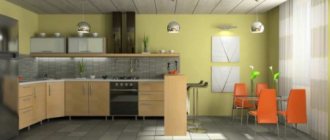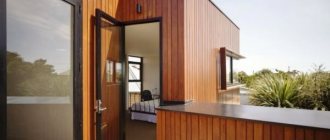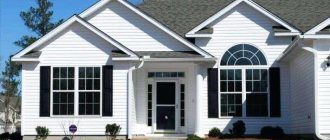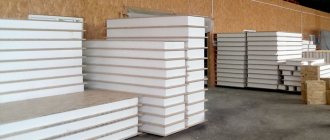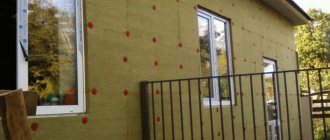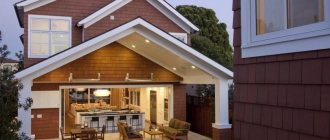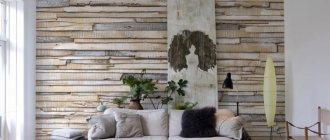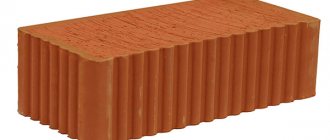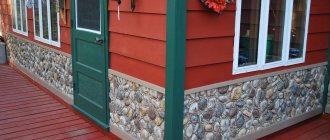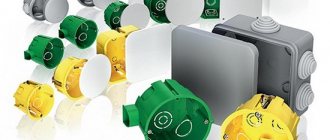The constructed house provides an opportunity to improve living conditions, but at the same time requires compliance with the parameters of functionality and aesthetics.
Any modern building materials from which the building is constructed must be decorated, and the structure itself must be insulated in order to achieve maximum energy saving.
The photo panels for the facade collected in this article help to visually evaluate their appearance and study in detail the features of the application. This will allow you to choose the best option for exterior design and attractive design of your own home, increasing its aesthetics and practicality of use.
Types of finishes for exterior work
Decorating and insulating facades with panels can be done with the help of specialists or with your own hands. To install the systems yourself, you need to familiarize yourself with their characteristics and the technology for installing materials, which will help you complete this process in the most efficient and fastest way possible:
- metal panels with wear-resistant polymer coating;
- panels made from natural wood fibers;
- vinyl curtain panels and sandwich panels with several layers;
- fiber cement systems and stone or porcelain tile panels;
- decorative panels imitating the texture of natural stone or brick.
To install individual facade panels, it is necessary to arrange a frame structure, but when choosing them it is important to take into account the architectural features of the building.
To create a high-quality heat shield, it is necessary to choose the right panels for facade finishing with a long service life and attractive design.
Types of facade panels
Wall panels are classified according to production material, shape and method of fastening.
The form is:
- rectangular;
- modular;
- long rectangular strips.
By dyeing method:
- under the tree;
- under brick;
- the front side is painted in a single color;
- under natural stone;
- imitation tiles.
The structure is standard (bare) and with insulation (sandwich panels). The slabs are made from raw materials:
- metal;
- glass;
- composite;
- wood;
- vinyl and polyurethane.
Certain types have locking fastenings.
The positive side is the characteristics of the species and its popularity.
Siding panels and boards
Siding is a type of cladding for which hinged ventilated facades are used that are easily secured to each other. The advantage of this type of exterior decoration is the protection of the building from precipitation and wind.
There is a large selection of this facade cladding on the market, which allows you to choose the one that best suits the buyer. The main advantages of siding:
- long service life;
- ease of installation;
- efficiency.
When choosing siding, the buyer learns that there are several types of cladding. They differ in load, strength, and care. Before purchasing siding, be sure to research all types.
Vinyl – PVC panels of different sizes
Successfully imitates wood, natural stone, brick. The positive aspects are: affordable price, lightness, resistance to various weather conditions. There are disadvantages: short service life, unstable to mechanical damage. When fastening units and ordinary material, the coefficient of linear expansion should be calculated. This will prevent deformation due to temperature changes.
Wood siding
Should be well dried or treated with antiseptic agents. This will prevent mold and parasites from appearing. The positive aspects are environmental friendliness, good thermal insulation, and high aesthetic qualities. But wood siding can warp. It has a short service life. It is highly flammable. Needs constant painting.
Metal siding
Used for cladding buildings. It is divided into types: aluminum, steel, zinc. The advantages of metal siding are strength, long service life, resistance to temperature changes, and no susceptibility to mold. The downside is poor sound insulation during rainy weather, as well as a high percentage of corrosion on cuts and peeling.
Fiber cement siding
Made from high quality cement, sand, water and cellulose fiber. This is a complete replacement for PVC siding. It is easy to install. He has no shortcomings. The positive aspects are that it does not ignite, is not afraid of precipitation, is strong, reliable, resistant to changes in air temperature, and does not rot.
Anyone can install such cladding without resorting to outside help. There are different types of siding profiles:
- “Herringbone” - single, double, triple.
- “Under the log” or “block house” is a laminating film with an imitation of natural logs. For naturalness, the corners are sheathed with a crown, which imitates the corner of a log house.
- “Ship plank” is an imitation of plank cladding. Each panel has a pair of wide parallel waves. Once installed, they create an overlapping effect between the laid boards. The design is highly resistant to water, mechanical and wind loads.
The profile does not affect the quality of raw materials. The texture imitates natural wood. A special polymer coating or paint is used to protect the material from scratches, corrosion, and impacts.
Siding can maintain its original appearance and quality for several decades. It is easy to use and maintain, and is also environmentally friendly. When dirty, it washes well and does not require painting.
Fiber cement boards
Fiber cement facade panels are considered environmentally friendly. They contain cement, cellulose and mineral fillers. It can even be used for interior cladding.
The light weight of the panel is one of the positive aspects of the material, since it reduces the load on the foundation.
Vinyl panels
Wall decoration with vinyl panels is well suited for furnishing a private home. The material is gaining popularity in decorative wall treatments. The reason for the rapid growth in demand is technical advantages.
- It is resistant to corrosion, rotting and other negative conditions.
- This is an environmentally friendly material.
- Mold or mildew will never grow under vinyl panels.
- The period of operation is at least 35 years.
- Vinyl panels are resistant to weather changes and temperature changes.
Even a beginner in the construction business can sheathe a building. The main thing is to be able to handle the tool and know the basic skills.
The negative quality of the material is fragility. There will be a high risk of damage to the panel if the fastening rules are not followed. Gaps may form between the panels, which will allow moisture and wind to pass through.
A serious disadvantage of vinyl is its tendency to mechanical stress. But damaged panels are easily replaced.
Polymer sand slabs
Polymer sand slab is a façade covering that imitates brickwork. This material is thin but durable. It consists of sand, polymers and various dyes. It does not crack during transportation and does not break when cutting.
The polymer sand board is glued or mounted on the sheathing. There is a wide range of colors, but the base is natural tiles.
Metal panels
The exterior cladding of buildings can be made using metal panels made from aluminum or galvanized steel. On the outside they are covered with a polymer layer, which creates anti-corrosion protection.
Metal elements are:
- perforated;
- corrugated;
- with additional ribs;
- smooth.
Positive sides:
- fire resistance;
- moisture resistance;
- strength;
- long period of use.
- resistance to different temperatures.
The disadvantage of metal panels is their heavy weight. In summer, the average air temperature will increase as the panels become very hot in the sun.
The structure of a metal panel cannot be restored when damaged; the panel will need to be replaced with a new one. This must be taken into account when calculating slabs.
Polypropylene facade panels
Plastic panels for facades are made from polypropylene with the addition of various other modifiers. For their manufacture, synthetic material polypropylene is used in sheets. Working with it is quick and easy. The main advantages are plasticity and elasticity.
They are resistant to external environmental influences. They are not afraid of high humidity, frost or elevated air temperatures. The advantages of the material include anti-corrosion properties, strength and long service life.
Polyurethane facade panels
Polyurethane panels are used for finishing external facades, as well as interior decoration. It is easy to install, light in weight, and has good thermal insulation properties. Often used for cladding commercial and industrial buildings.
Polyurethane panels are a decorative and finishing material that resembles a sandwich, that is, the outer side is made of zinc metal, in the middle there is a polyurethane thermal insulating filler.
This building material has many positive aspects:
- Resistant to mold, mildew and temperature changes.
- Moisture resistant.
- Fireproof.
- Light weight.
- Low cost.
- Good sound insulation.
- Easy to care for.
- No reinforced foundation is required during installation.
- Spacious transportation.
- Made from environmentally friendly raw materials.
Negative aspects include increased flammability. The material melts, releasing toxic smoke. Exposure to ultraviolet rays.
Facade thermal panels
Thermal panels are a combination of insulating and decorative layers. They are made of polystyrene foam, which combines the properties of insulation and a decorative facing layer.
Clinker tiles are used to cover the walls outside. She has a large palette of shades. It is glued into polystyrene foam, the seams are covered with marble chips. This gives the panel some personality.
Clinker thermal panels insulate walls and at the same time serve as an external decorative finish. With its help, heat is retained, sound insulation is enhanced and the appearance of the building is improved.
Facade sandwich panels
Sandwich slabs consist of several levels. The composition includes aluminum sheets between which there is insulation in the form of polystyrene foam or polyurethane foam. Sandwich boards are used in industrial construction.
- Advantages of sandwich panels:
- Savings on interior decoration;
- High installation speed;
- Installation is allowed at any time of the year.
This cladding does not require painting or additional decoration.
The disadvantage of sandwich slabs is freezing at the joints and peeling of the insulation at low temperatures.
Glass facade panels
Glass panels are rarely used in the cladding of external facades. Due to the complexity of installation and high cost, they are not popular in comparison with other varieties. The panels use tempered, impact-resistant, frosted and other types of glass. These panels are installed mainly in shopping and entertainment centers. They give the building originality and stand out from the crowd of other buildings.
Porcelain tiles
Porcelain tiles are a heavy and expensive type of building finishing. Used under high impact loads, strong winds and harsh climatic conditions. Porcelain tiles are mounted only on reinforced tile frames made from a special rigid profile. Experts do not recommend using it to decorate a bathhouse or sauna.
Wear resistance is good. The material perfectly withstands extreme frosts, moisture, chemical, thermal and shock loads.
Polymer coated
These finishes are made from galvanized metal, which determines their high wear resistance and affordable cost.
The protective and decorative polymer layer is painted at the application stage, so such materials are offered in a fairly wide variety of colors, which helps decorate the building.
Metal panels
Much stronger than the previous version. They go on sale in different forms. Cheap - facade panels made of galvanized steel. Expensive, but lighter and more durable - aluminum panels for facades. The surface can be smooth or perforated. Fixation is carried out using nails or metal screws.
Metal facade panels have the following advantages:
- Can be used at temperatures from -50 to +50 ℃.
- Easily attached to the facade.
- Will last more than 30 years.
- Protected from moisture.
- The impact resistance coefficient is 50 kg/cm.
- Facade aluminum panels are lightweight.
- They are not afraid of the influence of chemicals.
- They have a bending strength of up to 118 MPa.
Metal panels for the facade have the following disadvantages:
- insufficient thermal insulation. Metal is a cold material that will not insulate a house. Therefore, to reduce heat loss, thermal insulation materials such as mineral wool and foam are used;
- aluminum facade panels have a high cost.
Stone and brick finish
These panels for external façade finishing are optimally suited for basement finishing and are characterized by a fairly simple installation technology.
Their advantages are an extended service life combined with increased wear resistance and immunity to ultraviolet radiation and changing weather conditions.
Main criteria for choosing panels for the facade
Since facing panels not only give the house an attractive appearance, but also perform a number of protective functions, the choice of facade panels should be treated with special attention.
Any homeowner counts on the maximum service life of the cladding, long-term preservation of performance properties and an affordable price for the material. The appearance of the facade is certainly of great importance for the owner of the house, but one should not forget about the protective functions of the panels. The use of cladding allows you to protect the house from the negative effects of moisture, low temperatures, the spread of fungus and other harmful effects, including mechanical damage. In addition, some types of facing materials can be used as external insulation.
When choosing facade panels, special attention should be paid to the following main criteria:
- Terms of Use. Panels should be selected taking into account the minimum and maximum temperatures, the intensity of mechanical stress and other features;
- Possibility of self-installation of cladding. Installing the panels yourself will significantly reduce material costs;
- Cost of sheathing and fastening fittings;
- Mounting method. Facade panels can be attached either to a special frame or directly to the walls;
- The presence of a heat insulator on the inner surface of the panel;
- Performance characteristics of the panels, among which the most significant are:
- Environmental safety of the material;
- Antiseptic properties;
- Resistance to mechanical stress;
- Fire safety;
- Moisture resistance parameters;
- Warranty period;
- The complexity of installation and the number of necessary auxiliary elements.
- The cost per m2 of cladding takes into account the sheathing, fasteners and other elements necessary for installation.
In addition to these criteria, it should be remembered that the low cost of panels is most often due to the use of short-lived materials and components, however, the high price of cladding is not always a guarantee of quality.
Materials with wood fibers
Quite inexpensive and high-quality building materials are a multi-layer structure made from wood fibers.
To protect them from moisture, they are coated with a layer of paint, while they are quite easy to process and install by installing an aluminum sheathing made of building profiles, which will provide additional thermal insulation.
Wood-look façade board made of foam siding
Facade board made of foam siding (photo No. 8)
The ALTA BOARD facade board is the first foam siding produced in Russia. Thick and durable like fiber cement panels and lightweight like classic siding. Foam siding is approximately 3 times lighter than fiber cement siding. Suitable for any building and does not require wall alignment.
"ALTA BOARD" repeats the shape of wooden siding mounted in a herringbone pattern. But, unlike wood, it does not support combustion and is resistant to moisture and temperature changes. Does not require any special care - just wash the panels with water from a hose.
Strengths:
- Lightweight, does not place additional load on supporting structures. Suitable for any home.
- Resistant to moisture, mold, fungi and pests.
- Does not fade in the sun.
- Easy to install. You can handle the work yourself.
Weak sides:
- Installation is only “herringbone”, but this is a classic and tradition.
- The price is higher than regular siding, while the panels themselves are 6 times thicker and stronger (6 mm versus 1.1 mm).
Thermal panels for facades
A universal building material suitable for simultaneous insulation and cladding of the external walls of any building or structure.
The tight connection of individual elements with each other guarantees the absence of cold bridges, which can cause destruction of the walls or damage to their integrity.
How and how to caulk a timber house with your own hands: materials and step-by-step instructionsDigging wells
Wall masonry - tips for choosing bricks, calculating thickness and brick laying techniques (100 photos and videos)
Where to buy, how much they cost
When purchasing, you should follow simple recommendations. Buy all components made by one manufacturer and preferably in one store. Contact trusted companies, take an interest in the characteristics, ask questions to specialists.
The price of facade panels is determined by several factors. It is influenced by:
Quality and composition of the material. For example, facade siding is made of plastic with special additives that increase strength, durability and other characteristics. Accordingly, it is sold at a price higher than standard analogues.
Manufacturer and brand of product. The cost of facing brick or stone facing panels from different manufacturers depends on the location, raw materials and technology used. Of course, brand popularity also affects the price.
Surface appearance. Products that have a texture that imitates wood or natural stone are more expensive than those that have a smooth surface.
Coating color. Facade panels for exterior finishing of a house made from brick or natural stone must have a very durable coating. It must maintain a rich color, and for this they use special stabilizers and technologies that require certain costs. The price of such products will be higher than that of plain and light ones.
Wall mounted sandwich panels
The multilayer construction of these materials allows you to create a high-quality ventilated facade from panels for buildings of any type.
The metal layer, insulation and vapor barrier make such panels indispensable when arranging residential premises equipped with energy-saving heating systems.
How installation work is performed
Most often, external wall panels are mounted according to the principle of a ventilated facade. No wet work, the technology is simple and accessible to everyone. Using a wooden or metal profile, a sheathing is created on the wall, onto which the cladding will be fixed. Depending on the chosen method, fastening occurs using self-tapping screws, clamps, and nails. The photo below shows what a ventilated facade system looks like.
Ventilated facade
Tools for work
The example shows that façade panels with insulation were used. It's practical and convenient. But what else is needed for installation work?
List of tools and materials:
- metal or wooden profile;
- vapor barrier and waterproofing film;
- façade ceramic panels or any other (it all depends on desire);
- anchor dowels and umbrella dowels;
- perforator;
- insulation material;
- fastening elements;
- antiseptic (if wood is used);
- bracket for ventilation façade;
- screwdriver;
- tape measure, level, marker;
- additional elements to the facade.
Installation of facing material
Step-by-step instruction:
- The walls are cleaned so that thermal insulation can be easily done.
- A ventilation façade project is being created and thermal insulation work is being carried out.
- Installation of brackets. Using a hammer drill, holes are made in the right places for the dowels. The drill should be 1 cm larger than the diameter of the dowel.
- The facade guide is mounted and the frame is created. We need a whole system of profiles.
- When the frame is ready, the facing material is fixed to it.
All further work depends on what types of facade panels are used for cladding the house. You can use hidden installation or use the system provided by the manufacturer. All these nuances are considered at the purchase stage. An experienced consultant will help you understand fastening technology.
Thus, we learned how to decorate the facade of a house with panels imitating stone, wood, brick or other material. The only thing you may have problems with is choosing the appropriate option. Nevertheless, after comparing all the characteristics: appearance, pros and cons, everyone will be able to settle on a certain option. It is worth considering that when choosing facade cladding, it is important to make sure that the products have a quality certificate and can last for decades.
Porcelain tiles for facade
Porcelain stoneware, which appeared on the market not so long ago, has managed to gain recognition among experienced builders due to its range of operational parameters. This material is excellent for equipping new buildings or buildings after major and current repairs; such panels are easy to install and create all the conditions for ventilation of the walls.
A separate category of finishing materials includes glass panels and decor made of polyurethane foam. They are used less frequently than clinker panels for facades due to their sufficient fragility and installation complexity, which makes it difficult to independently install such building materials.
Manufacturers and prices
The stores have a large selection of not only types of facade panels, but also their manufacturers. There are both domestic representatives who create competitive material, and foreign companies that have proven themselves many years ago.
The cost of cladding depends on the manufacturer and the material from which it is made. Our manufacturers' products are slightly lower. Prices are indicated per piece or linear meter. Please pay attention to this when calculating the quantity and cost of materials.
- Alta-profile - a Russian manufacturer offers the cheapest panels for facades at a price of 440 rubles per piece.
- FineBer is also our creator of façade panels. Offers the cheapest option at a price of 460 rubles/piece.
- Döcke – façade panels from Germany can be purchased from 460 rubles/piece.
- Holzplast is another representative of German quality, which will please you with the cost of panels starting from 460 rubles/piece.
- Nailite is an American representative, the price for the cheapest option starts from 800 rubles/piece.
As you can see, the range of facade panels is so diverse that everyone will be able to choose the appropriate option. When purchasing, pay attention to the storage conditions of the material. Often, during improper storage, products lose their properties.
What material to use to decorate the façade of a house: summary table
Let's compare materials based on key indicators:
- Environmental friendliness
- Strength
- Fire safety
- Temperature range of use
- Moisture resistance
- Resistance to temperature changes and aggressive environments
- Color fastness
- Minimum service life
- Installation features
- Maintenance during use
- Availability.
| Exterior plaster | A natural stone | Siding | Facade panels | Flexible tiles | Fiber cement siding | Facade board "ALTA BOARD" | |
| Environmental friendliness | Combined material, environmentally friendly | Natural environmentally friendly material | Non-natural material, environmentally friendly | Non-natural material, environmentally friendly | Unnatural material | Non-natural material, environmentally friendly | Non-natural material, environmentally friendly |
| Strength | Average | High | Average | High | Low | High | High |
| Fire safety | Does not burn | Does not burn | Does not support combustion | Does not support combustion | Medium flammability, self-extinguishing | Does not burn | Does not support combustion |
| Temperature Range | -30…+45 | -60…+80 | -60…+80 | -60…+60 | Up to +110 | -40…+80 | -50…+60 |
| Moisture resistance | + | + | + | + | + | + | + |
| Resistance to temperature changes | Depends on the type of plaster | + | + | + | + | + | + |
| Resistance to aggressive environments | + | + | + | + | — | + | + |
| Color fastness | Depends on the type | High | Depends on the type | High | High | High | High |
| Life time | 15…25 years | From 30 years or more | Up to 30 years or more | Up to 30 years or more | Up to 30 years or more | Up to 50 years | Up to 30 years or more |
| Installation | Only in warm dry weather. | Mounted on an adhesive mixture. Only in warm, dry weather | Mounted on the sheathing. All year round. | Mounted on the sheathing. All year round | Mounted on OSB boards using a special adhesive mixture. Only in warm and dry weather. | Mounted on the sheathing. All year round | Mounted on the sheathing. All year round down to -10 °C. |
| Care | Wash with water. Can be repainted | Wash with a hose | Wash with a hose and non-abrasive cleaners | Wash with a hose and non-abrasive cleaners | Wash very carefully | Wash with a hose and non-abrasive products. Can be repainted. | Wash with a hose and non-abrasive cleaners |
| Cost/sq.m, from | 600 rub. | 2500 rub. | 250-400 rub. | 770 RUR | 800 rub | 1350 rub. | 950 rub. |
